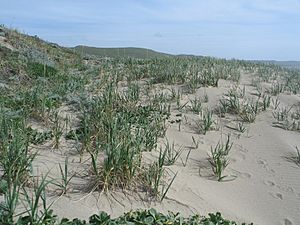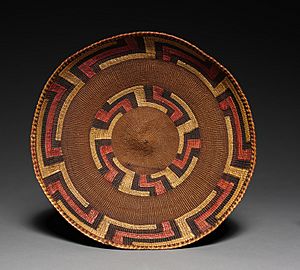American dune grass facts for kids
Quick facts for kids American dune grass |
|
|---|---|
 |
|
| subsp. mollis in California | |
| Conservation status | |
| Scientific classification | |
| Genus: |
Leymus
|
| Species: |
mollis
|
| Synonyms | |
|
Elymus mollis |
|
Leymus mollis is a type of grass often called American dune grass or sea lyme-grass. In Japan, it's known as hamaninniku. This grass grows naturally in parts of Asia, including Japan, China, Korea, and Russia. It's also found in northern North America, across Canada, the northern United States, and Greenland. You can even spot it in Iceland.
Contents
How It Grows
This grass is a perennial plant, meaning it lives for more than two years. It has special underground stems called rhizomes. These rhizomes help the plant spread and grow new shoots. Its upright stems can reach up to 1.7 meters (about 5.5 feet) tall.
The leaves can be almost a meter long (about 3 feet) and up to 1.5 centimeters (about half an inch) wide. The flower spike, which holds the seeds, can be up to 34 centimeters (about 13 inches) long. Each small flower cluster, called a spikelet, can have up to six tiny flowers.
There are two main types, or subspecies, of Leymus mollis. One type, called villosissimus, mostly grows in cold arctic areas, usually near the coast. It's often smaller than the other type, mollis. It can be tricky to tell them apart, even when they grow in the same place. The best way to tell them apart is by looking at the tiny hairs on their flower parts. Subspecies villosissimus has long, soft, shaggy hairs. Subspecies mollis has finer, thinner hairs, and usually fewer of them.
Where It Lives
This grass loves to grow in coastal areas, especially on dunes. It plays a very important role in keeping these sandy areas healthy. The grass often grows on the front dunes, which are closest to the ocean. It's one of the first plants to grow when a new sand dune starts to form.
In these loose, ocean-facing dunes, the plants have to be very tough. They can handle salty ocean spray, salty sand, and very little fresh water. They also survive unstable ground, occasional flooding during storms, and strong winds. Even if young plants get buried by sand, they can often still grow.
The grass has a large network of rhizomes underground. These rhizomes act like anchors, holding the plant firmly in the shifting sand. When many of these plants grow together on a dune, their rhizomes connect. This network helps to hold the sand in place, stopping erosion. It's like the "skeleton" of the dune. Because of this, Leymus mollis is very useful for restoring natural beach areas.
Plant Neighbors
Many other plants grow alongside Leymus mollis on the dunes. Some common plant neighbors include Lathyrus japonicus (beach pea), Achillea millefolium (yarrow), and Festuca rubra (red fescue). You might also see Ammophila breviligulata (beach grass), Rhus typhina (staghorn sumac), and Rosa rugosa (beach rose).
This grass also grows with mosses like Pleurozium shreberi and Polytrichum species. You can find lichens such as Cladina species too. Scientists have noticed that Leymus mollis is one of the most common plants in the snow goose nesting areas in the arctic. It's believed the geese like the whole environment where the grass grows, not just the grass itself.
A Super Plant for the Future
Scientists are very interested in Leymus mollis because it is so tough and adaptable. They are studying it to see if its special traits can be used to improve other plants, especially wheat.
Wheat is a very important food crop, but it can be damaged by things like drought, salty soil, and diseases. Leymus mollis can survive these harsh conditions easily. Scientists are trying to combine Leymus mollis with wheat to create new types of wheat that are stronger and more resistant to problems.
For example, a special type of Leymus mollis was found to be resistant to a plant disease called powdery mildew. When scientists crossed this Leymus mollis with wheat, they created new wheat plants that were also resistant to powdery mildew. This shows that Leymus mollis has valuable genes that can help make our food crops better.
This grass can survive dry periods for many days. Even when there's very little water, its young plants can still grow. This is a big difference from wheat seedlings, which often die in dry conditions.
Leymus mollis also handles salty soil very well. Its seeds can sprout even after being in saltwater for a week. This means it can grow in places where most other plants can't.
Because of its amazing ability to tolerate drought, salt, and diseases, Leymus mollis is seen as a very useful plant for the future. As the world changes and we need more food, scientists are looking for ways to make our crops more resilient. The special traits of Leymus mollis – like its strong roots, ability to survive being buried, and resistance to fungal diseases – could help us grow more food in challenging environments.
Human Uses

This grass has been used by people for a long time. Many Indigenous peoples in North America have found creative ways to use it.
The Makah, Nitinaht, and Quileute peoples used bunches of the thick roots to rub their bodies while bathing. Yupik peoples used the leaves to make useful items like mats, baskets, bags, and ropes for hanging fish to dry. The Hesquiat people wove the leaves into handles for their sacks.
The Kwakwakaʼwakw people made baskets and hats from the leaves. They also traditionally used the leaves to line the boxes where they cooked lupine roots. The Nitinaht people used the pointed leaves for sewing and tying things.
The Haisla people used the grass to line pits where they prepared oil from the eulachon fish. The Quinault people placed salal fruits on a bed of the leaves to dry them. Inuit people in Canada have traditionally used Leymus mollis to help with stomach problems and to weave baskets. They also used dried leaves to keep their boots warm.
Environmental Concerns
Even though Leymus mollis is not a rare or endangered plant, its populations can be affected by human activities. Things like building new developments, damage from storms, and people's recreational activities can harm its coastal home. In some areas, other plants that were brought in from different places, like Ammophila arenaria (European beach grass), have taken over its habitat.
There are also special types of Leymus mollis that have been grown for specific uses. Two examples are 'Reeve' and 'Benson'. The 'Benson' type was named after Benny Benson, a 13-year-old boy who designed the official flag of Alaska. This type was developed to help regrow plants on sand dunes that have been damaged by erosion.


